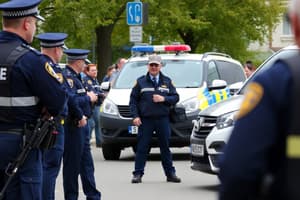Podcast
Questions and Answers
Which factor most directly prompted the emergence of community policing in the late 20th century?
Which factor most directly prompted the emergence of community policing in the late 20th century?
- A surge in federal funding for law enforcement agencies.
- Increasing isolation of police from the communities they served. (correct)
- Widespread adoption of military tactics by police forces.
- Decreasing crime rates in urban areas.
What is the primary distinction between traditional policing models and community policing?
What is the primary distinction between traditional policing models and community policing?
- Traditional policing focuses on reactive responses to crime, while community policing emphasizes collaboration and problem-solving. (correct)
- Traditional policing emphasizes proactive crime prevention, while community policing focuses on reactive law enforcement.
- Traditional policing prioritizes community involvement, while community policing relies solely on law enforcement expertise.
- Traditional policing utilizes advanced technology, while community policing relies on traditional methods.
How did social unrest and civil rights movements of the 1960s influence the development of community policing?
How did social unrest and civil rights movements of the 1960s influence the development of community policing?
- By highlighting the need for police reform and improved community relations. (correct)
- By diverting resources away from law enforcement agencies.
- By reinforcing the effectiveness of traditional policing methods.
- By promoting stricter law enforcement policies.
Which of the following best represents the core principles that define community policing?
Which of the following best represents the core principles that define community policing?
Why is community policing considered a 'new way of thinking' rather than just a program?
Why is community policing considered a 'new way of thinking' rather than just a program?
Which individual is recognized as a significant early influence on community policing through their advocacy for police professionalism and education?
Which individual is recognized as a significant early influence on community policing through their advocacy for police professionalism and education?
In what way did Robert Peel's principles of policing contribute to the development of community policing strategies?
In what way did Robert Peel's principles of policing contribute to the development of community policing strategies?
What was the significance of 'team policing' as an early influence on community policing?
What was the significance of 'team policing' as an early influence on community policing?
Which factor primarily prompted the re-evaluation of traditional policing models in the 1970s?
Which factor primarily prompted the re-evaluation of traditional policing models in the 1970s?
What was a key provision of the Violent Crime Control and Law Enforcement Act of 1994 regarding community policing?
What was a key provision of the Violent Crime Control and Law Enforcement Act of 1994 regarding community policing?
How does the Broken Windows Theory contribute to the philosophy of community policing?
How does the Broken Windows Theory contribute to the philosophy of community policing?
What role does the Community Oriented Policing Services (COPS) Office play in advancing community policing?
What role does the Community Oriented Policing Services (COPS) Office play in advancing community policing?
Which outcome is most directly associated with successful implementation of community policing strategies?
Which outcome is most directly associated with successful implementation of community policing strategies?
In the context of community policing, what is the significance of Herman Goldstein's concept of Problem-Oriented Policing?
In the context of community policing, what is the significance of Herman Goldstein's concept of Problem-Oriented Policing?
How did the Flint, Michigan, Foot Patrol Program influence the development of community policing strategies?
How did the Flint, Michigan, Foot Patrol Program influence the development of community policing strategies?
Besides terrorism and cybercrime, what is another modern challenge that community policing aims to address by building trust and enhancing communication?
Besides terrorism and cybercrime, what is another modern challenge that community policing aims to address by building trust and enhancing communication?
Flashcards
Community Policing
Community Policing
A philosophy promoting partnerships between police and citizens to solve community problems.
Partnership
Partnership
Working together to identify, prioritize, and solve community issues.
Problem Solving
Problem Solving
Actively finding and fixing the root causes of issues in neighborhoods.
Prevention
Prevention
Signup and view all the flashcards
Limitations of Traditional Policing
Limitations of Traditional Policing
Signup and view all the flashcards
Breakdown of Trust
Breakdown of Trust
Signup and view all the flashcards
Team Policing
Team Policing
Signup and view all the flashcards
August Vollmer
August Vollmer
Signup and view all the flashcards
Problem-Oriented Policing
Problem-Oriented Policing
Signup and view all the flashcards
Violent Crime Control and Law Enforcement Act of 1994
Violent Crime Control and Law Enforcement Act of 1994
Signup and view all the flashcards
Flint, Michigan, Foot Patrol Program
Flint, Michigan, Foot Patrol Program
Signup and view all the flashcards
Broken Windows Theory
Broken Windows Theory
Signup and view all the flashcards
Community Oriented Policing Services (COPS) Office
Community Oriented Policing Services (COPS) Office
Signup and view all the flashcards
Impact of Community Policing
Impact of Community Policing
Signup and view all the flashcards
Enhanced Problem Solving
Enhanced Problem Solving
Signup and view all the flashcards
Study Notes
- Community policing represents a philosophical and organizational shift towards partnership between citizens and police.
- The foundation is the collaboration between police and the community to define, prioritize, and resolve issues like crime, drugs, fear, social disorder, and decay.
- It is a fundamental change in how the role of police in the community is viewed.
- There is a shift in police culture, management, and operations, with the police working with the community to address the root causes of crime and disorder.
- The ultimate aim is to improve community quality of life, foster trust, and create understanding between police and residents.
Core Components of Community Policing
- Partnership is the collaboration between law enforcement and the community.
- Problem Solving means the proactive identification and resolution of community issues.
- Prevention focuses on dealing with the underlying causes of crime.
History of Community Policing
- Community policing arose in the late 20th century because police were increasingly isolated from communities.
- Traditional policing, focused reactively on law enforcement, was proving inadequate for complex community problems.
- Contributing factors include:
- Recognition of traditional model shortcomings.
- Rising concerns over trust between police and communities.
- Community organizations and advocacy groups were on the rise.
- Social science had advanced on crime and disorder.
Early Influences
- August Vollmer, the father of modern policing, championed police professionalism and education in policing in the early 20th century.
- Robert Peel's policing principles, with their focus on crime prevention and community relations, influenced community policing.
- Team Policing was an early tactic of assigning officers to neighborhoods to build relationships.
Development of Community Policing
- 1960s: Social unrest and civil rights movements emphasized the need for police reform and improved community relations.
- 1970s: Research questioned the effectiveness of traditional policing models and their effect on crime and satisfaction.
- 1980s: The community policing movement grew, including pilot programs and community engagement strategies.
- Herman Goldstein developed Problem-Oriented Policing, highlighting the need to address the root causes of crime.
- 1990s: Community policing gained widespread acceptance, with support from government and law enforcement organizations.
- The 1994 Violent Crime Control and Law Enforcement Act provided funding for community policing and hiring officers.
- 2000s-Present: Community policing continues to evolve, building trust, communication, and challenges like terrorism and cybercrime.
Key Milestones and Developments
- The Flint, Michigan, Foot Patrol Program was an early experiment that showed the advantages of foot patrols in reducing crime and improving community relations.
- James Q. Wilson and George L. Kelling proposed The Broken Windows Theory which argued that addressing minor disorder can prevent bigger crimes.
- The Community Oriented Policing Services (COPS) Office, established by the Justice Department in 1994, offers funding, training, and assistance to law enforcement agencies implementing community policing.
Impact of Community Policing
- Community policing improves relationships by fostering trust between police and the community.
- Crime rate reduction is achieved by addressing the root causes of crime and disorder.
- Problem solving is enhanced with police and communities collaborating to identify and solve problems effectively.
- Citizen satisfaction is increased through community policing, improving the quality of life.
Studying That Suits You
Use AI to generate personalized quizzes and flashcards to suit your learning preferences.
Description
Community policing is a strategy promoting partnership between citizens and police. Together, they address issues like crime and social disorder, shifting police culture towards community collaboration. The goal is improved quality of life and mutual trust.




